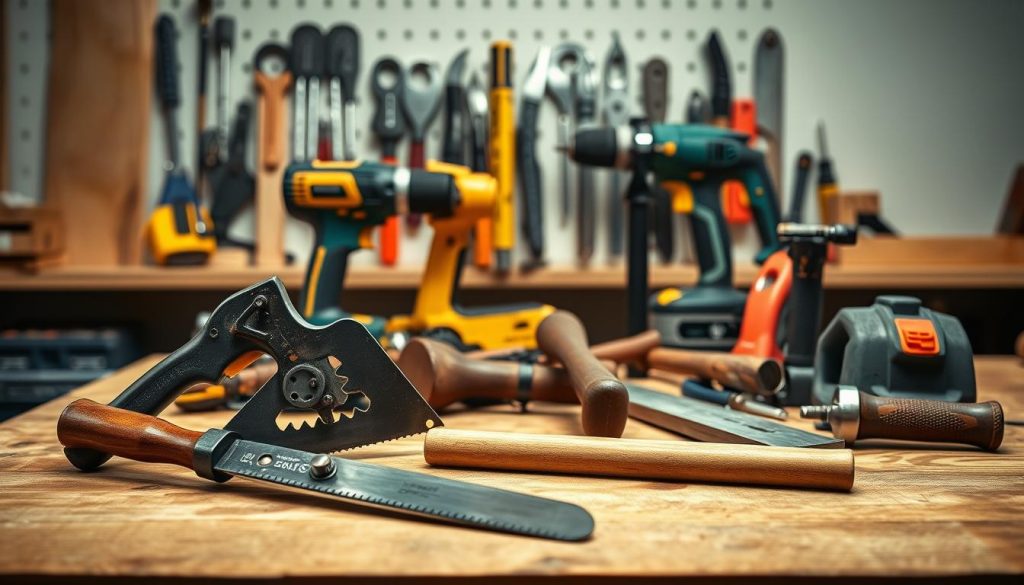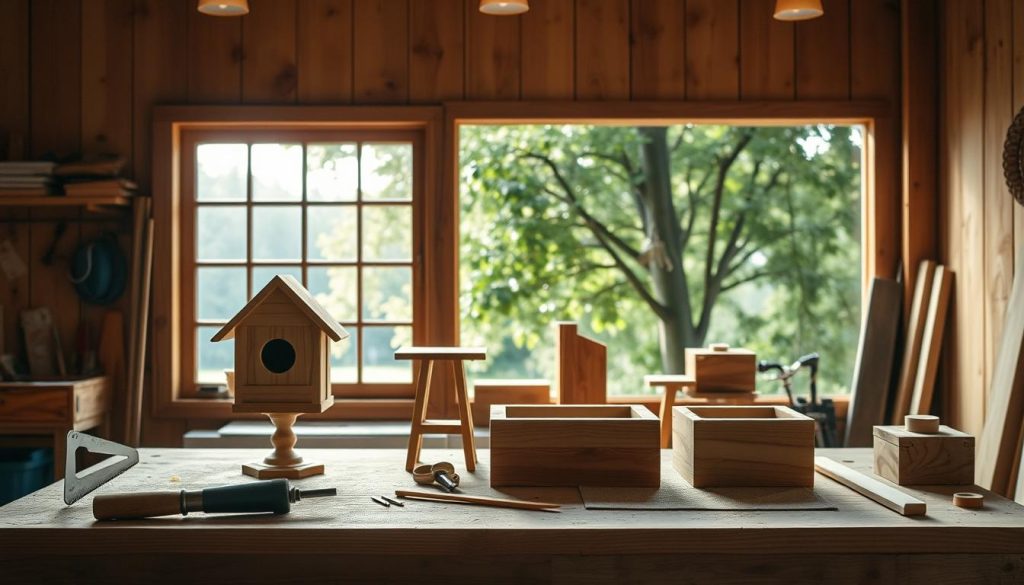Woodworking is an exciting journey that turns raw materials into stunning creations. It’s perfect for beginners who want to try DIY woodworking. This craft lets you develop skills, unleash your creativity, and make functional pieces by hand.
DIY woodworking is more than just making furniture. It’s a rewarding hobby that connects you to a long tradition of craftsmanship. Whether you want to build a simple bookshelf or intricate decorative items, woodworking for beginners is a great way to learn practical skills and show off your unique artistic vision.
To start your woodworking adventure, you need passion, patience, and a desire to learn. With the right guidance and basic tools, anyone can turn raw wood into beautiful, personalized creations. These creations tell a story of skill and dedication.
Key Takeaways
- Woodworking is an accessible hobby for all skill levels
- Create functional and decorative items with your own hands
- Learn valuable skills that improve with practice
- Develop creativity through hands-on crafting
- Connect with a community of passionate woodworkers
Why Choose DIY Woodworking?
Woodworking is more than a hobby. It opens doors to creativity, skill, and personal pride. DIY woodworking lets you turn raw materials into beautiful, useful items with your own hands.
Benefits of DIY Projects
Woodworking projects bring many benefits to all skill levels. They help you develop practical skills and offer a creative outlet.
- Enhances problem-solving abilities
- Develops spatial reasoning skills
- Provides stress relief through focused crafting
- Builds confidence through tangible results
Cost-Effective Solutions
DIY woodworking is a budget-friendly way to decorate your home and make furniture. With basic tools and materials, you can make custom pieces at a lower cost than buying them.
- Save money on expensive furniture
- Create personalized gifts
- Repair and refurbish existing items
- Generate potential side income
Personal Satisfaction
There’s no feeling quite like finishing a woodworking project yourself. Each piece is a mix of creativity, skill, and personal achievement. It’s something store-bought items can’t match.
Woodworking is rewarding for beginners and experienced crafters alike. It’s a journey of skill and self-expression.
Essential Tools for Beginners
Starting your woodworking journey requires the right tools and supplies. Beginners often feel overwhelmed by the variety of equipment. But understanding the basics can help you build a solid foundation for your craft.

Building a comprehensive toolkit doesn’t mean breaking the bank. You can start with a few essential items. These items will serve you well in most DIY projects.
Must-Have Hand Tools
- Hammer: A versatile tool for driving nails and light tapping
- Measuring tape: Crucial for accurate project measurements
- Chisels: Different sizes for carving and detailed work
- Hand saw: For manual cutting of wood pieces
- Level: Ensures straight and even surfaces
Power Tools for DIY Woodworking
As you progress, power tools can significantly enhance your woodworking capabilities. Consider investing in these entry-level tools:
- Cordless drill: Perfect for creating holes and driving screws
- Circular saw: Ideal for straight cuts and larger wood pieces
- Random orbital sander: Provides smooth finishing surfaces
Tool Maintenance Tips
Proper care of your woodworking tools extends their lifespan and ensures optimal performance. Keep tools clean, store them in a dry place, and regularly check for any signs of wear or damage. Lubricate moving parts and sharpen cutting edges to maintain their effectiveness.
Remember, building your woodworking tool collection is a gradual process. Start with basics, learn their use, and expand your toolkit as your skills improve.
Choosing the Right Wood for Your Projects
Choosing the right wood is key in woodworking. Beginners often find it hard to pick the best wood for their projects. The wood you choose can greatly affect your project’s outcome.
Types of Wood for Beginners
Woodworking starts with knowing different wood types. For beginners, some great woods to start with are:
- Pine: Soft, affordable, and easy to work with
- Oak: Durable and perfect for furniture
- Maple: Hard wood with beautiful grain patterns
- Cedar: Naturally resistant to decay
Understanding Wood Grain
Wood grain affects how your wood looks and works. Straight grains are simpler to work with. Irregular grains can add unique textures. Always consider grain direction when cutting and joining to get smooth results.
Where to Buy Quality Lumber
Finding good woodworking supplies is crucial. Here are some places to buy:
- Local lumber yards
- Home improvement stores
- Specialty woodworking shops
- Online wood suppliers
Always check the wood before buying. Look for straight boards without warping, cracks, or big knots. These can harm your project’s quality.
Simple DIY Woodworking Projects
Starting with beginner woodworking projects can really boost your creativity and skills. These projects are a great way for newbies to try out woodworking plans. You’ll make useful and lovely items for your home.

Simple projects are a great way to start. They help you build confidence and learn the basics. You can pick from many DIY projects that need just a few tools and basic knowledge.
Building a Basic Bookshelf
A bookshelf is a perfect first project for woodworking fans. Here’s how to make one:
- Choose straight, lightweight wood like pine
- Measure and cut shelves to the right size
- Sand edges for a smooth finish
- Use wood glue and basic screws to put it together
Creating Rustic Wooden Planters
Wooden planters are great for outdoor spaces and are a good way to practice your skills. Here’s what to keep in mind:
- Use weather-resistant wood
- Make drainage holes
- Apply protective wood sealant
- Customize size and design
Making a Wooden Picture Frame
Making a picture frame is a great way to practice cutting and joining. Start with simple frames and get better at more complex ones as you go.
Remember, woodworking success comes from patience, practice, and a desire to learn. Every project makes you more confident and skilled.
Safety Tips for Woodworking
Woodworking is a rewarding hobby, but it has risks. Safety is key for anyone woodworking. Always protect yourself before starting a project.
Professional woodworkers know safety is a must. The right safety tips can prevent injuries. This makes woodworking a positive experience.
Importance of Protective Gear
Protecting yourself is crucial when working with wood and tools. Essential safety gear includes:
- Safety glasses to protect eyes from flying debris
- Hearing protection during loud cutting operations
- Dust masks to prevent respiratory issues
- Work gloves for hand protection
- Tight-fitting clothing to avoid catching on tools
Safe Cutting Techniques
Safe cutting needs focus and the right technique. Always stand steady, keep hands away from edges, and use push sticks with table saws or routers.
First Aid for Common Injuries
Accidents can still happen. Keep a first aid kit in your workshop. Learn basic wound care and have emergency numbers ready.
No project is worth risking your health. Start with good safety habits in woodworking.
Techniques to Master
For beginners, mastering core woodworking techniques is key to making stunning DIY projects. Woodworking tutorials guide you through the essential skills needed to turn raw materials into beautiful pieces. These skills will boost your confidence and precision in woodworking.
Measuring and Marking with Precision
Accurate measurements are the base of successful woodworking projects. Woodworking experts suggest using specific tools for precise measuring:
- Tape measure with clear markings
- Carpenter’s square
- Marking gauge
- Combination square
Essential Cutting Techniques
Learning various cutting methods is crucial for clean and accurate woodworking. Beginners should focus on:
- Crosscut saw techniques
- Circular saw safety
- Miter saw precision
- Bandsaw cutting methods
Joining Wood Like a Pro
Connecting wood pieces needs practice and knowledge of different joining methods. Essential techniques include:
- Butt joints for simple connections
- Dado joints for stronger alignments
- Mortise and tenon joints for advanced projects
- Pocket hole joining for quick assemblies
Practice is key to mastering these woodworking techniques. Start with simple projects and gradually improve your skills. Always focus on detail and safety.
Finishing Your Woodworking Projects
The final stage of any woodworking project is crucial. It protects your hard work and makes it look professional. Mastering finishing techniques can turn a simple wooden piece into a stunning masterpiece.
Proper finishing involves several key steps. These steps will take your woodworking tutorials from amateur to professional-level craftsmanship.
Sanding Basics
Sanding is the foundation of a smooth, professional finish. Start with coarse-grit sandpaper and move to finer grits for the best results.
- Begin with 80-grit sandpaper for rough surfaces
- Move to 120-grit for initial smoothing
- Finish with 220-grit for a silky-smooth surface
Staining and Sealing
Staining adds color and depth to your wooden projects. Choose a stain that complements the wood’s natural grain and your desired aesthetic.
- Test stain on scrap wood first
- Apply thin, even coats
- Wipe excess stain to prevent blotching
Choosing the Right Finish
The final protective layer is critical for durability and appearance. Different woodworking techniques require different finishes.
- Polyurethane: Excellent for high-traffic items
- Lacquer: Provides a smooth, hard finish
- Oil finishes: Great for bringing out wood’s natural beauty
Experiment with various woodworking techniques to find the perfect finish for your unique project. Remember, patience and attention to detail are key to achieving a professional-looking result.
Inspiration for Your Next Project
Woodworking is a journey of learning and creativity. Finding inspiration can improve your skills and spark new ideas. The woodworking community offers many resources to help you grow and stay motivated.
Online Resources and Communities
Digital platforms have changed how woodworkers connect and share knowledge. Online woodworking tutorials offer endless ideas and guidance. Key resources include:
- Woodworking forums like WoodworkingTalk
- Reddit woodworking subreddits
- Pinterest boards with creative woodworking plans
- Instagram accounts of professional woodworkers
Following Industry Experts
Professional woodworkers are great sources of inspiration. They share tutorials and project walkthroughs on various platforms:
- YouTube channels featuring woodworking techniques
- Woodworking blogs with step-by-step guides
- Podcasts discussing craft innovations
Visiting Local Woodworking Shops
Local woodworking shops offer hands-on learning that online resources can’t match. These spaces have workshops, classes, and chances to meet skilled craftspeople. Talking to local experts can help you find new plans and improve your skills.
Troubleshooting Common Issues
Woodworking comes with its own set of challenges. These tests your skills and patience. Learning to solve common problems is key for beginners.
Wood splitting and measurement errors are common. Experts suggest keeping extra materials for practice. Using sharp tools and measuring twice can help avoid mistakes.
Warped wood is another issue for beginners. Knowing why it warps, like moisture or bad storage, helps fix it. Simple fixes like using weights or storing wood in a controlled environment can help.
Feeling stuck? Talking to experienced woodworkers can help a lot. Join local clubs, online forums, or workshops. Remember, every pro started as a beginner. A willingness to learn will speed up your progress.